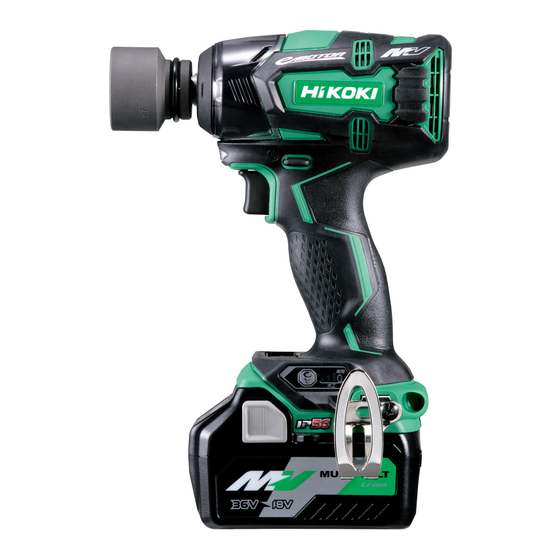HIKOKI WR 36DC Taşıma Talimatları Kılavuzu - Sayfa 11
Elektrikli Alet HIKOKI WR 36DC için çevrimiçi göz atın veya pdf Taşıma Talimatları Kılavuzu indirin. HIKOKI WR 36DC 17 sayfaları.

Regarding electric discharge in case of new batteries,
etc.
As the internal chemical substance of new batteries and
batteries that have not been used for an extended period
is not activated, the electric discharge might be low when
using them the fi rst and second time. This is a temporary
phenomenon, and normal time required for recharging
will be restored by recharging the batteries 2 – 3 times.
How to make the batteries perform longer.
(1) Recharge the batteries before they become completely
exhausted.
When you feel that the power of the tool becomes
weaker, stop using the tool and recharge its battery. If
you continue to use the tool and exhaust the electric
current, the battery may be damaged and its life will
become shorter.
(2) Avoid recharging at high temperatures.
A rechargeable battery will be hot immediately after
use. If such a battery is recharged immediately after
use, its internal chemical substance will deteriorate, and
the battery life will be shortened. Leave the battery and
recharge it after it has cooled for a while.
CAUTION
○ If the battery is charged while it is heated because
it has been left for a long time in a location subject to
direct sunlight or because the battery has just been
used, the charge indicator lamp of the charger lights
for 0.3 seconds, does not light for 0.3 seconds (off for
0.3 seconds). In such a case, fi rst let the battery cool,
then start charging.
○ When the charge indicator lamp fl ickers (at 0.2-second
intervals), check for and take out any foreign objects in
the charger's battery connector. If there are no foreign
objects, it is probable that the battery or charger is
malfunctioning. Take it to your authorized Service
Center.
○ Since the built-in micro computer takes about
3 seconds to confi rm that the battery being charged with
UC18YSL3 is taken out, wait for a minimum of 3 seconds
before reinserting it to continue charging. If the battery
is reinserted within 3 seconds, the battery may not be
properly charged.
MOUNTING AND OPERATION
Action
Removing and inserting the battery
Charging
Mounting the socket
Reversing the rotational direction
Switch operation
Removing and mounting the hook
Remaining battery indicator
How to use the LED light
Tightening mode selector
function
*3
Charging a USB device from a
electrical outlet
Charging a USB device and
battery from a electrical outlet
How to recharge USB device
When charging of USB device is
completed
Selecting accessories
*1 Installing a socket
Select the socket to be used.
(1) Slide the O-ring out of the groove, then align the hole
of the socket with the hole of the anvil and insert the
anvil into the socket.
(2) Insert the pin into the socket.
(3) While making sure that the pin doesn't fall, attach the
O-ring to the groove on the socket.
*2 How to use the LED light
NOTE
To prevent the battery power consumption caused
by forgetting to turn off the LED light, the light goes off
automatically in about 2 minutes.
*3 Tightening mode selector function
CAUTION
Select tightening mode while the trigger switch is
released. Failure to do so could result in malfunction.
By using the Tightening mode selector switch on the side
of the tool body, the tightening torque can be adjusted
according to the type of work.
The Tightening mode switches between 5 diff erent modes
each time the Tightening mode selector switch is pressed.
In Single mode, when the switch is pulled and impacting
begins, the power tool automatically stops after a few
impacts.
In Low, Medium, High and Wood modes, when the switch
is pulled and impacting begins, the power tool impacts
continuously (without automatically stopping).
Wood mode is ideal for tightening screws or bolts into wood
materials.
Use Wood mode for tasks like tightening coach bolts.
NOTE
Use High mode for heavy-load tasks like assembling
steel frames.
Using Wood mode to tighten bolts into steel panels or
steel frames may overload the impact mechanism of the
tool and result in failure.
11
Figure
1
2
*1
3
4
5
6
7
8
*2
9
10-a
10-b
11
12
―
Page
2
2
2
2
2
3
3
3
3
3
3
4
4
15
